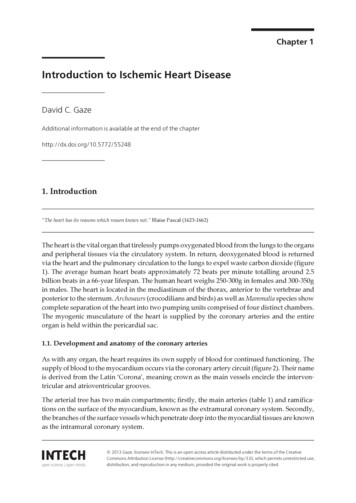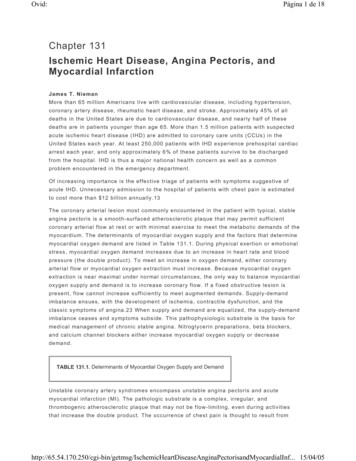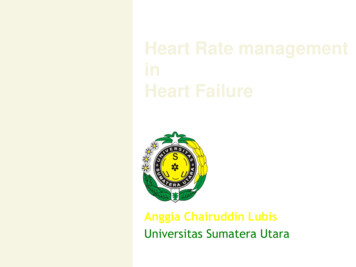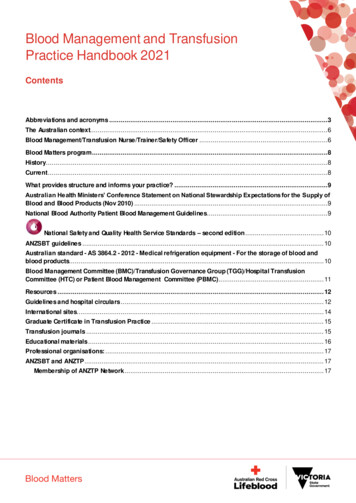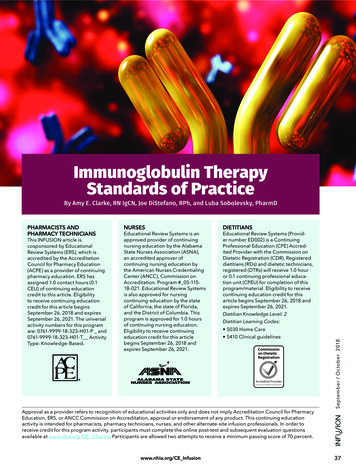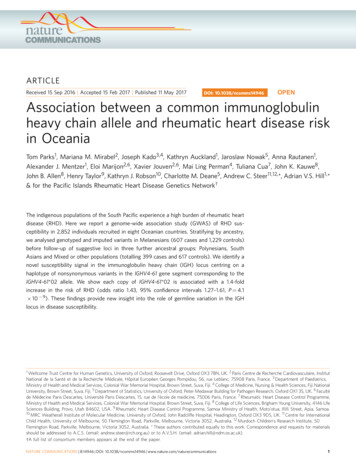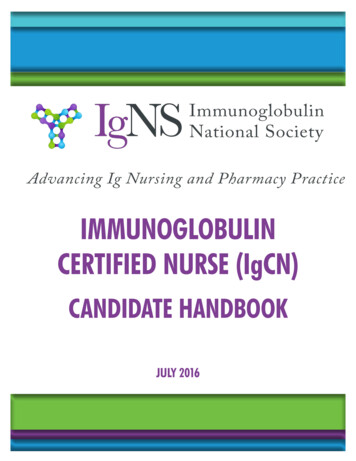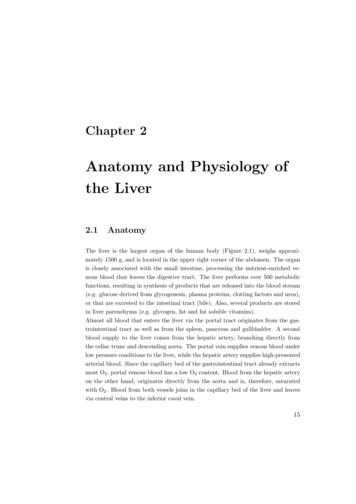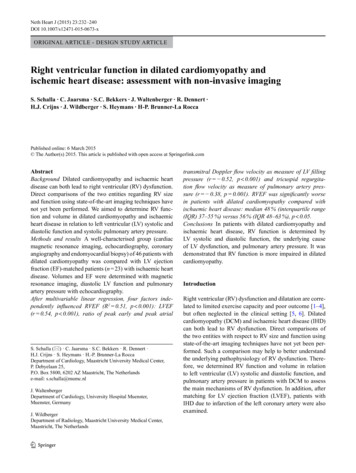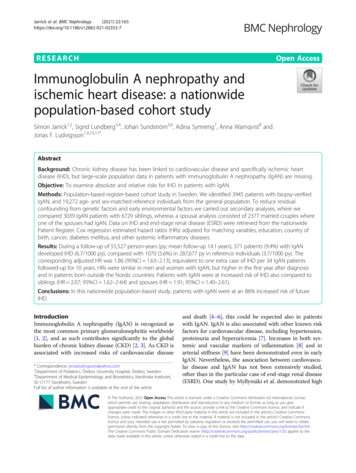
Transcription
Jarrick et al. BMC Nephrology(2021) SEARCHOpen AccessImmunoglobulin A nephropathy andischemic heart disease: a nationwidepopulation-based cohort studySimon Jarrick1,2, Sigrid Lundberg3,4, Johan Sundström5,6, Adina Symreng7, Anna Warnqvist8 andJonas F. Ludvigsson1,9,10,11*AbstractBackground: Chronic kidney disease has been linked to cardiovascular disease and specifically ischemic heartdisease (IHD), but large-scale population data in patients with immunoglobulin A nephropathy (IgAN) are missing.Objective: To examine absolute and relative risks for IHD in patients with IgAN.Methods: Population-based register-based cohort study in Sweden. We identified 3945 patients with biopsy-verifiedIgAN, and 19,272 age- and sex-matched reference individuals from the general population. To reduce residualconfounding from genetic factors and early environmental factors we carried out secondary analyses, where wecompared 3039 IgAN patients with 6729 siblings, whereas a spousal analysis consisted of 2377 married couples whereone of the spouses had IgAN. Data on IHD and end-stage renal disease (ESRD) were retrieved from the nationwidePatient Register. Cox regression estimated hazard ratios (HRs) adjusted for matching variables, education, country ofbirth, cancer, diabetes mellitus, and other systemic inflammatory diseases.Results: During a follow-up of 55,527 person-years (py; mean follow-up 14.1 years), 371 patients (9.4%) with IgANdeveloped IHD (6.7/1000 py), compared with 1070 (5.6%) in 287,677 py in reference individuals (3.7/1000 py). Thecorresponding adjusted HR was 1.86 (95%CI 1.63–2.13), equivalent to one extra case of IHD per 34 IgAN patientsfollowed-up for 10 years. HRs were similar in men and women with IgAN, but higher in the first year after diagnosisand in patients born outside the Nordic countries. Patients with IgAN were at increased risk of IHD also compared tosiblings (HR 2.07; 95%CI 1.62–2-64) and spouses (HR 1.91; 95%CI 1.40–2.61).Conclusions: In this nationwide population-based study, patients with IgAN were at an 86% increased risk of futureIHD.IntroductionImmunoglobulin A nephropathy (IgAN) is recognized asthe most common primary glomerulonephritis worldwide[1, 2], and as such contributes significantly to the globalburden of chronic kidney disease (CKD) [2, 3]. As CKD isassociated with increased risks of cardiovascular disease* Correspondence: jonasludvigsson@yahoo.com1Department of Pediatrics, Örebro University Hospital, Örebro, Sweden9Department of Medical Epidemiology and Biostatistics, Karolinska Institutet,SE-17177 Stockholm, SwedenFull list of author information is available at the end of the articleand death [4–6], this could be expected also in patientswith IgAN. IgAN is also associated with other known riskfactors for cardiovascular disease, including hypertension,proteinuria and hyperuricemia [7]. Increases in both systemic and vascular markers of inflammation [8] and inarterial stiffness [9] have been demonstrated even in earlyIgAN. Nevertheless, the association between cardiovascular disease and IgAN has not been extensively studied,other than in the particular case of end-stage renal disease(ESRD). One study by Myllymäki et al. demonstrated high The Author(s). 2021 Open Access This article is licensed under a Creative Commons Attribution 4.0 International License,which permits use, sharing, adaptation, distribution and reproduction in any medium or format, as long as you giveappropriate credit to the original author(s) and the source, provide a link to the Creative Commons licence, and indicate ifchanges were made. The images or other third party material in this article are included in the article's Creative Commonslicence, unless indicated otherwise in a credit line to the material. If material is not included in the article's Creative Commonslicence and your intended use is not permitted by statutory regulation or exceeds the permitted use, you will need to obtainpermission directly from the copyright holder. To view a copy of this licence, visit http://creativecommons.org/licenses/by/4.0/.The Creative Commons Public Domain Dedication waiver ) applies to thedata made available in this article, unless otherwise stated in a credit line to the data.
Jarrick et al. BMC Nephrology(2021) 22:165rates of IHD and cerebrovascular disease in a cohort of220 patients with biopsy-proven IgAN, although outcomeswere not identically defined in exposed and unexposedgroups [10].In a large, nationwide cohort of patients with biopsyproven IgAN, we recently demonstrated increased overall and cardiovascular mortality, compared with thematched general population [11]. The current study usesthe same cohort to examine incident cardiovascular disease in IgAN. The aim of the study was to examine fatalor nonfatal IHD in patients with IgAN compared with amatched reference population, by linking biopsy data tonational health registers. Additional comparisons withsiblings and spouses allowed us to reduce confoundingdue to shared risk factors within families and increaseour understanding of IgAN and cardiovascular diseaseeven further. We hypothesized that patients are at increased risk of IHD.Materials and methodsRegistersThe Swedish personal identity number is a unique 10digit code assigned to every Swedish resident at birth orimmigration. The personal identity number enables largescale data linkages of multiple national registers [12].The Swedish Total Population Register [13] containsdemographic data on all Swedish residents, includingdates of birth, death, immigration and emigration, placeof birth and residence, sex, spouse, and educational level.The Total Population Register also includes the MultiGeneration Register, linking all first-degree relatives toall individuals born in Sweden since 1932 who were stillalive in 1961.The Swedish National Patient Register lists hospitalstays since 1964, with national coverage since 1987, andhospital outpatient visits since 2001. The register contains information on admission and discharge, main andadditional diagnoses, and surgical procedures, with corresponding International Classification of Diseases (ICD)codes and procedure codes. A validation of the PatientRegister confirmed a high diagnostic accuracy of 85–95% for most diagnoses, with more severe diagnosestending to be more accurate [14].The Swedish Cause of Death Register was started in1952, with complete coverage since 1961. Registration ofthe cause of death must be completed within 3 weeksfrom the death certificate, and is fulfilled in about 99.5%of deceased (the ICD code R99.9 is used for theremaining 0.5%) [15].The Swedish Prescribed Drug Register contains informationabout drug expenditures for prescribed drugs in the entireSwedish population, from July 1, 2005, onwards. Hospitaladministered drugs and over-the-counter medications are notPage 2 of 8included. Patient identity data are available for 99.7% of all records [16].Definition of IgAN and inclusion of patientsWe defined IgAN as having a biopsy record of IgAN(1974–2011) at any of the four pathology departmentswhere all renal biopsy specimens in Sweden are evaluated. In 3 units (Stockholm, Gothenburg, and Linköping), biopsy records where screened for the SnoMed CT(Systematized Nomenclature of Medicine – ClinicalTerm) codes D67300 (IgAN) and T71000 (kidney) [17].One unit (Malmö/Lund) did not provide SNOMEDcodes, and biopsy reports from this region werereviewed manually (see Welander et al. [18] for a detailed description). The resulting cohort of 4125 individuals with a biopsy report of IgAN was validated throughmanual review of complete patient charts from a random subset of 127 patients, confirming the diagnosis in95.3% (95% confidence interval (CI): 91.6–98.9%) of thecases [19]. Since we studied first occurrence of IHD asthe outcome, we excluded all IgAN patients and all primary and secondary reference individuals with the ICDcodes corresponding to IHD before inclusion date (seesupplemental eTable S2 for definitions).Matched reference individuals (controls)For each patient with IgAN, the government agency Statistics Sweden (SCB) identified up to five reference individuals from the Total Population Register matched forage, sex, calendar year, and county of residence at thetime of renal biopsy in the index patient. Controls withIgAN at inclusion were excluded.Secondary comparison groupsTo account for residual confounding factors that couldnot be statistically adjusted for, we used the multigeneration register to identify secondary comparison groupsthat could be expected to share genetic, environmentaland behavioral risk factors with the IgAN patients. Thus,patients with IgAN were compared with siblings andspouses (defined as the first person an IgAN patient waslegally married to). IgAN patients without siblings, orwho were never married, were excluded from the respective analyses. We also excluded relatives with IgANat inclusion.Follow-upThe date of IgAN diagnosis was defined as the dateof the first renal biopsy indicating IgAN. Follow-up inIgAN patients began at diagnosis and on the samedate in matched reference individuals, siblings andspouses, and ended with studied outcome underexamination, death, emigration, or May 312,017,whichever occurred first.
Jarrick et al. BMC Nephrology(2021) 22:165OutcomesOur main outcome was the first instance of any IHD,defined as the occurrence of either myocardial infarctionor angina pectoris (please see supplemental eTable S2for corresponding ICD codes) in the patient register, oras the underlying (but not as of the contributory) causein the Cause of Death Register. We also studied myocardial infarction separately.CovariatesWe collected information on relevant demographic andclinical factors present at inclusion, which could influencecardiovascular risk as possible confounders. Data on sex,country of birth, and educational level were retrieved fromthe Total Population Register. Data on relevant comorbidity (diabetes, cancer, systemic inflammatory diseases otherthan IgAN and cardiovascular disease other than IHD andhypertension) were extracted from the Patient Register.Heredity for IgAN was defined as having 1 first-degreerelative with a biopsy report of IgAN before study entry ofthe index individual. First-degree relative were identifiedthrough the multigeneration register and did not includespouses.ESRD was defined as the first occurrence in the patient register of any ICD code for CKD stage 5, or anyICD code or procedure code associated with dialysis orkidney transplantation (supplemental eTable S3). To increase specificity, three or more records of an ESRDdiagnosis were required, with at least 4 months betweenthe first and the last diagnosis.As hypertension is commonly caused by chronic kidney disease including IgAN, and a known risk factor forIHD, it was considered as a mediator rather than a confounder and not adjusted for in the models.Statistical analysisWe used Cox regression with internal stratification (eachIgAN individual was compared with his or her matchedreference individuals) to calculate hazard ratios (HRs)for any IHD (our main outcome) as well as myocardialinfarction. Since proportionality over time was not verified statistically, HRs were considered as estimates of thegeometric mean of the true, changing HRs [20], but wealso presented HRs in the first year of follow-up.Event-free survival was presented graphically usingCox adjusted survival diagrams.All analyses were adjusted for educational level ( 9,9–12, and 13 years), country of birth (Nordic, includingSweden, vs. non-Nordic countries), and the presence atbaseline of cardiovascular disease, cancer, diabetes mellitus, and other systemic inflammatory diseases (supplementary eTable S1 for definitions). Comparisons withgeneral population reference individuals were also adjusted for heredity for IgAN and ESRD. As sibling andPage 3 of 8spousal analyses could not be matched for sex and age,these analyses were instead adjusted for in the Coxmodel. Throughout the study, we exclusively report adjusted HRs. We also calculated IHD- and diseasespecific incidence rates per 1000 person-years (py) inIgAN patients and reference individuals, and present absolute excess rates (unadjusted).We used Stata Statistical Software, release 15 (StataCorpLP, College Station, TX) for the statistical calculations. Pvalues 0.05 were considered statistically significant.EthicsThe study was approved by the Stockholm Ethics ReviewBoard (January 22, 2014; Dnr 2013/2095–31/2). Becausethis was a strictly register-based study, informed consentwas waivered by the Board [21]. The current study wascarried out in accordance with relevant guidelines andregulations.ResultsDemographics and background variablesWe identified 4125 individuals with IgAN. After exclusion of 180 individuals with IHD before inclusion date,3945 were included in the final analyses (Table 1). Extrarenal manifestations of IgA vasculitis (Henoch-Schönleinpurpura) were present in 170 (4.3%). Those 3945 patients were compared to 19,272 matched reference individuals (main analysis). The sibling analysis compared3039 IgAN patients with 6729 siblings, whereas thespousal analysis consisted of 2377 married couples.In the main analysis, the median age at inclusion inboth groups was 39 years. The male to female ratioamong IgAN patients was 2.4:1. The mean (standard deviation) follow-up time was 14.1 (8.5) years for IgAN patients versus 14.9 (8.5) years for reference individuals,with similar follow-up in sibling and spousal analyses.Other demographic characteristics were similar betweengroups. Among IgAN patients, 1241 (31.5%) had a diagnosis of hypertension, compared to 344 (1.8%) amongmatched reference individuals. Diabetes and concomitant systemic inflammatory disease were more commonin IgAN patients compared to all comparison groups.Hypertension was present in 31.5% of the IgAN patientsand 1.8% of the reference individuals at inclusion, and50.1% of IgAN patients had a hypertension diagnosis anytime during follow-up. Among 1343 IgAN patients included after July 12,005 when we had access to data onmedication, glucocorticoids were prescribed to 784(58.4%), and other immunosuppressive drugs to 345(25.7%) patients during follow-up, and for 178 (13.3%) and93 (6.9%) patients during the first year after biopsy. Reninangiotensin-aldosterone system inhibitors (RAASi) wereused in 1172 (87.3%) and other antihypertensive drugs in841 (62.3%) IgAN patients, and in 516 (38.4%) and 354
Jarrick et al. BMC Nephrology(2021) 22:165Page 4 of 8Table 1 Descriptive baseline characteristics of patients with IgAN compared to matched general population reference individuals,siblings and spousesMain analysisSibling analysisSpousal analysisIgANGeneral populationreferenceIgANSiblingsIgANSpousesn (%)n (%)n (%)n (%)n (%)n (%)Total394519,2723039672923772377Person-years (py)55,527287,67744,796105,09635,484 (0)38,893 (0)Female1172 (29.7%)5780 (30.0%)869 (28.6%)3307 (49.1%)690 (29.0%)1710 (71.9%)Male2773 (70.3%)13,492 70.0%)2170 (71.4%)3422 (50.9%)1687 (71.0%)667 (28.1%)Age, mean (SD)39.4 (16.5)38.9 (16.2)35.9 (14.9)35.3 (16.6)43.5 (14.3)42.9 (14.6)Age, median (IQR)38.9 (26.5, 51.3) 38.3 (26.2, 50.5)35.3 (23.9, 47)35.7 (23, 47.9)43.1 (32.7, 53.9) 42.8 (32.3, 53.2) 17 years380 (9.6%)1894 (9.8%)361 (11.9%)1093 (16.2%)64 (2.7%)91 (3.8%)18–39 years1706 (43.2%)8541 (44.3%)1485 (48.9%)2872 (42.7%)943 (39.7%)947 (39.8%)SexAge40–59 years1390 (35.2%)6778 (35.2%)1015 (33.4%)2312 (34.4%)1046 (44.0%)1036 (43.6%) 60 years469 (11.9%)2059 (10.7%)178 (5.9%)452 (6.7%)324 (13.6%)296 (12.5%)0 (0.0%)7 (0.3%)UnknownYear of inclusionEntry year, median (IQR)2001 (1994,2007)2001 (1994, 2007)2002 (1994,2008)2001 (1994,2007)2000 (1993,2006)2000 (1993,2006)1974–1988438 (11.1%)2168 (11.2%)317 (10.4%)728 (10.8%)326 (13.7%)326 (13.7%)1989–20011565 (39.7%)7662 (39.8%)1187 (39.1%)2670 (39.7%)1024 (43.1%)1024 (43.1%)2002–20151942 (49.2%)9442 (49.0%)1535 (50.5%)3331 (49.5%)1027 (43.2%)1027 (43.2%)Mean (SD)14.1 (8.47)14.9 (8.52)14.7 (8.49)15.6 (8.51)14.9 (8.76)16.4 (8.67)Median (IQR)12.7 (7.45, 19.6) 13.7 (8.11, 20.7)13.5 (7.99, 20.4) 14.5 (8.61, 21.5) 13.8 (8.01, 20.7) 15.5 (9.3, 22.5)0–1 years79 (2.0%)194 (1.0%)35 (1.2%)41 (0.6%)56 (2.4%)20 (0.8%)1–4 years464 (11.8%)2001 (10.4%)314 (10.3%)569 (8.5%)248 (10.4%)176 (7.4%) 5 years3402 (86.2%)17,077 88.6%)2690 (88.5%)6119 (90.9%)2073 (87.2%)2181 (91.8%)3022 (76.6%)16,000 83.0%)2524 (83.1%)6020 (89.5%)1759 (74.0%)2021 (85.0%)Follow up timeReason for end of follow upMay 31, 2017Emigration105 (2.7%)727 (3.8%)80 (2.6%)160 (2.4%)48 (2.0%)45 (1.9%)IHD (death or diagnosis)371 (9.4%)1070 (5.6%)206 (6.8%)242 (3.6%)290 (12.2%)126 (5.3%)Death from other cause447 (11.3%)1475 (7.7%)229 (7.5%)307 (4.6%)280 (11.8%)185 (7.8%)Country of birthNordic3602 (91.3%)17,322 89.9%)2971 (97.8%)6568 (97.6%)2128 (89.5%)2085 (87.7%)Non-Nordic342 (8.7%)1948 (10.1%)68 (2.2%)161 (2.4%)249 (10.5%)229 (9.6%)Unknown1 ( 1%)2 ( 1%)0 (0.0%)0 (0.0%)0 (0.0%)63 (2.7%)Level of educationCompulsory school (0–9 years)817 (20.7%)Upper sec. School (10–12 years) 1759 (44.6%)3852 (20.0%)506 (16.7%)1195 (17.8%)527 (22.2%)435 (18.3%)8690 (45.1%)1415 (46.6%)3205 (47.6%)1007 (42.4%)1044 (43.9%)University ( 12 years)1276 (32.3%)6279 (32.6%)1066 (35.1%)2090 (31.1%)816 (34.3%)817 (34.4%)Unknown93 (2.4%)451 (2.3%)52 (1.7%)239 (3.6%)27 (1.1%)81 (3.4%)236 (6.0%)30 (0.2%)203 (6.7%)22 (0.3%)94 (4.0%)5 (0.2%)ComorbitityaHSP/IgAVb
Jarrick et al. BMC Nephrology(2021) 22:165Page 5 of 8Table 1 Descriptive baseline characteristics of patients with IgAN compared to matched general population reference individuals,siblings and spouses (Continued)Main analysisSibling analysisSpousal analysisIgANGeneral , type 1 or 2170 (4.3%)309 (1.6%)97 (3.2%)107 (1.6%)101 (4.2%)45 (1.9%)Other systemic inflammatorydisease313 (7.9%)459 (2.4%)224 (7.4%)207 (3.1%)193 (8.1%)77 (3.2%)Hypertension1241 (31.5%)344 (1.8%)891 (29.3%)139 (2.1%)809 (34.0%)51 (2.1%)Heredity for IgAN38 (1.0%)28 (0.1%)Heredity for ESRD84 (2.1%)139 (0.7%)Continuous parameters are presented as mean values with standard deviations. Categorical values are presented as numbers and percentages. For all definitions,see main text or Additional file 1aBefore study inclusion date (biopsy date in IgAN patients and corresponding date in reference individuals)bHSP/IgAV Henoch-Schönlein’s purpura, or systemic IgA vasculitis(26.4%) respectively during the first year. Statins were prescribed to 578 (43.0%) patients during follow-up, and to162 (12.1%) in the first year (supplemental eTable S4).Main outcome: any ischemic heart disease (IHD)During a follow-up of 55,527 person-years (py), 371 patients (9.4%) with IgAN had at least one record of anyIHD (6.7 per 1000 py), compared with 1070 (5.6%) during287,677 py in reference individuals (3.7 per 1000 py)(Figs. 1 and 2, supplemental eTable S5). The unadjustedabsolute excess rate was 3.0 per 1000 py. The corresponding adjusted HR was 1.86 (95%CI 1.63–2.13), equivalentto one extra case of IHD per 34 IgAN patients followed-up for 10 years. The HRs were similar across subgroups.The rate of IHD was higher in the first year after inclusion(8.5 per 1000 py; HR 2.63 (95%CI 1.57–4.41)), and increased both among Nordic (6.58 per 1000 py; HR 1.83(95%CI 1.59–2.1)) and non-Nordic individuals (7.97 per1000 py; HR 2.52 (95%CI 1.53–4.14)). The HR for IHDdid not differ significantly between women (1.72; 95%CI 1.24–2.37) and men (1.90; 95%CI 1.64–2.21). For allother strata, HRs were of the same magnitude comparedto the general population reference individuals. Risk estimates were generally similar when IgAN patients werecompared to their siblings (HR 2.07; 95%CI 1.62–2-64)(supplemental eTable S6) and spouses (HR 1.91;Fig. 1 Event-free survival in patients with IgA nephropathy, compared with matched reference individuals, siblings and spouses, presented asKaplan-Meier diagrams, with ischemic heart disease as outcome
Jarrick et al. BMC Nephrology(2021) 22:165Page 6 of 8Fig. 2 Forrest plots presenting adjusted hazard ratios for ischemic heart disease in IgA nephropathy compared to general population controls,siblings and spouses. Legend: HSP, Henoch-Schönlein Purpura95%CI 1.40–2.61), with the exception of a significantlyhigher HR for IHD in men than in women in spousal analysis (supplemental eTable S7).Secondary outcome: myocardial infarction (MI)Restricting the outcome to myocardial infarction (MI),there were 216 events (5.5%) during 56,865 py in IgA patients, versus 662 events (3.4%) during 291,433 py in reference individuals, with an unadjusted absolute excessrate of 1.5 per 1000 py (one case in 65 individualsfollowed for 10 years), and a corresponding adjusted HR(aHR) of 1.83 (95%CI 1.54–2.18) (supplemental eTableS8). Non-Nordic origin was associated with a higheraHR (3.67; 95%CI 1.37–9.84).DiscussionIn the current nation-wide, population-based study including more than 3900 patients diagnosed with IgANin Sweden over a study period of 37 years, we found an86% increased risk of IHD, equivalent to one extra caseof IHD per 34 IgAN patients followed-up for 10 years.The IHD excess risk was present across a range of IgANsub-populations and compared to siblings and spouses.Similar HRs were seen for myocardial infarction.Previous studies have shown vascular changes with increased arterial stiffness in IgAN patients even at earlystages [9, 22]. Consistently, we found hypertension in almost one third of IgAN patients already at the time of biopsy, compared to less than 2 % in a matched referencepopulation, and half of the patients had hypertensionduring follow up (according to ICD code; 87% were prescribed RAAS inhibitors, which might have been intendedalso for treatment of proteinuria, and 62% other antihypertensive drugs). There is also robust evidence that CKDpatients experience a risk increase for cardiovascularevents and death with increasing CKD stage, long beforethey reach ESRD [4–6, 23]. Indeed, one Finnish studyfound tripled odds for cardiovascular disease in IgAN patients compared with an age- and sex-matched referencepopulation derived from national health survey data anddoubled odds when only IgAN patients with stable nonprogressive kidney disease were included [10]. The deviation from our results might in part be due to a differentpatient selection (we used national biopsy data and didnot rely on tertiary center data), our use of biopsy recordsto define IgAN (positive predictive value 95% [19]), andthat the Finnish study derived their reference populationfrom survey interviews, while we relied on national healthregisters with physician-reported data.After adjusting for potential confounders includingprevalent comorbidity, we found similar HRs in bothmen (1.72) and women (1.90). We also noted a strongassociation between IgAN and IHD in the first year afterIgAN. This may reflect a more intense clinical work-upfor symptoms suggestive of IHD when the IgAN patientshave frequent healthcare visits. We chose to examineIHD-naïve IgAN patients and hence excluded individualswith a prior IHD diagnosis. We did so to be able to estimate the future risk of IHD in IgAN, a topic of interestto many patients.
Jarrick et al. BMC Nephrology(2021) 22:165Strengths and limitationsWe followed more than 3900 IgAN patients and 19,200reference individuals for a mean follow up time of 14years. Through linkage to the personal identity numberwe virtually eliminated loss of follow-up using nationwide registers on emigration status, and death. Thenumber of IHD cases in IgAN (n 371) to our knowledge exceeds the total number reported in the literatureup to date. This allowed us to calculate both relative andabsolute risks with substantial precision. We were ableto demonstrate a clearly increased risk (HR 1.86), butalso to rule out huge excess risks (the upper 95%CI inour study signals that a more than 2.2-fold risk increaseis unlikely). Our absolute risk estimates will help physicians convey an understandable message to IgAN patients (one extra case of IHD in 34 IgAN patientsfollowed-up for 10 years). The nationwide, populationbased design should minimize selection bias. The Swedish national health registers are well validated and ofhigh quality. Through the Patient Register (positive predictive value for most disorders have been estimated at85–95%) [14], we retrieved information on importantpotential confounders such as diabetes, other inflammatory conditions and cancer. Furthermore, our data wereadjusted for education and country of birth. Additionally, the large number of study participants enabled usto carry out stratified analyses which will allow cliniciansto optimize information (same HR in women and menbut higher HRs in the first year after diagnosis). The inclusion of a reference population matched for sex andcalendar year enabled us to perform Cox regression withinternal stratification. We compared IgAN patients notonly with the general population, but also with their siblings and spouses. Very similar HRs in these secondarycomparisons indicate that the increase in IHD is relatedto IgAN, and not to shared genetic and early environmental factors. Finally, our exposure was confirmedthrough biopsy. In an earlier validation study, 121/127(95%) randomly selected IgAN patents from our cohorthad IgAN according to patient chart records. IgA deposits were reported in 97% of the biopsy records (n 123), mesangial hypercellularity in 76% (n 96), C3 deposits in 89% (n 113).We also acknowledge some limitations. We did nothave information on cardiovascular risk factors such asglomerular filtration rate, proteinuria or precise bloodpressure levels, but it can be argued that these intermediates should not be adjusted for, as these factors are tobe considered mediators rather than confounders. Still,stratification on such markers of disease severity couldhave deepened understanding of risk estimates. We alsolack information on smoking. As previous studies havefound similar smoking patterns in IgAN patients and thegeneral population [24], smoking habits are unlikely toPage 7 of 8have biased our results. Except for IgAN related toHenoch Schönlein purpura/IgA vasculitis, our data didnot let us distinguish primary IgA from secondaryforms.In conclusion, this nationwide population-based studyfound an 86% increased risk of future IHD in patientswith IgAN.AbbreviationsCKD: Chronic kidney disease; ERSD: End-stage Renal disease;IgAN: Immunoglobulin A nephropathy; IHD: Ischemic heart diseaseSupplementary InformationThe online version contains supplementary material available at nal file 1: Table S1. Internationalclassification of disease (ICD)codes for renal disease, cardiovasculardisease, diabetes, cancer, HenochSchönlein purpura and other systemicinflammatory diseases. Table S2.International classification of disease (ICD) codes for ischemic heart disease. Table S3. Definitionof renal endpoints. Table S4. AnatomicalTherapeutical Chemical (ATC) codes for medications, used for matching totheSwedish Prescribed Drugs register. Table S5. Adjustedhazardratios(HRs) for ischemic heart diseasecompared with the general referencepopulation (corresponding to column 1 in Fig. 2). Table S6. Adjustedhazardratios (HRs) for ischemic heart diseasecompared with siblings(correspondingto column 2 in Fig. 2). Table S7. Adjustedhazardratios(HRs) for ischemic heart diseasecompared with spouses (correspondingtocolumn 3 in Fig. 2). Table S8. Adjustedhazard ratios (HRs) for acute myocardialinfarction compared with the generalreference population.AcknowledgementsNone.Authors’ contributionsSJ and JFL conceived and designed the study with input from the otherauthors. SJ and JFL wrote the first draft of the paper. JFL supervised theproject. JFL obtained funding for data collection and register-based linkages.AW analyzed the data. All authors interpreted the data and contributed tothe writing of the paper. All authors revised and approved the final version.JFL had full access to all the data and takes responsibility for the integrity ofthe data. AW takes responsibility for the accuracy of the data analyses.FundingOpen Access funding provided by Karolinska Institute.Availability of data and materialsThe data that support the findings of this study are available from the NationalBoard of Health and Welfare, the government agency Statistics Sweden, andthe Pathology departments delivering IgAN data, but restrictions apply to theavailability of these data, which were used under license for the current study,and so are not publicly available. Data are however available from the authorsupon reasonable request and with permission of the National Board of Healthand Welfare, the government agency, Statistics Sweden, and the Pathologydepartments delivering IgAN data.DeclarationsEthics approval and consent to participateThis project (2013/2095–31/2) was approved by the Ethics Review Board inStockholm, Sweden on January 22, 2014. Because this was a strictly registerbased study, informed consent was waivered by the Board.Consent for publicationNot applicable.
Jarrick et al. BMC Nephrology(2021) 22:165Competing interestsNone.Author details1Department of Pediatrics, Örebro University Hospital, Örebro, Sweden.2Faculty of Health and Medicine, Örebro University, Örebro, Sweden.3Department of Nephrology, Danderyd Hospital, Stockholm, Sweden.4Department of Clinical Sciences, Karolinska Institutet, Danderyd Hospital,Stockholm, Sweden. 5Department of Medical Sciences, Clinical Epidemiology,Uppsala University, Uppsala, Sweden. 6The George Institute for Global Health,University of New South Wales, Sydney, Australia. 7Clinical EpidemiologyDivision, Department of Medicine, Solna, Kar
burden of chronic kidney disease (CKD) [2, 3]. As CKD is associated with increased risks of cardiovascular disease and death [4-6], this could be expected also in patients with IgAN. IgAN is also associated with other known risk factors for cardiovascular disease, including hypertension, proteinuria and hyperuricemia [7]. Increases in both sys-
